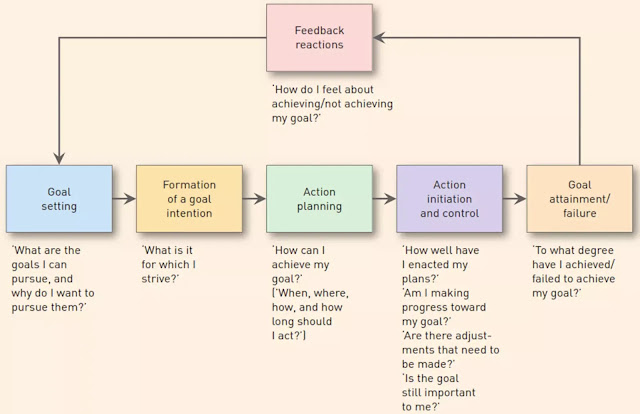34.7 Goals and Motivation
Difference between goal and wants: you make progress (strive) for goal, but you do not necessarily make progress on your want (in the literature, there isn’t want0
Difference between goal and motivation: goal is regarding progress, while motivation is related to wish, and desire. (similar to wants). In the literature, sometimes interchangeable. But used to be that goal (end state), motivation (the drive to the end state)
Goal can be salient or not.
Kunda (1990)
Motivated reasoning
Motivation is mediated cognitive processes to affect reasoning.
Motivation is defined as “any wish, desire, or preference that concerns the outcome for a given reasoning task.” (p. 480)
Reasoning tasks include: forming impressions, determining one’s beliefs and attitudes, evaluating evidence, and making decisions.
Motivated reasoning phenomena include:
those in which the motive is to arrive at an accurate conclusion
those in which the motive is to arrive at a particular, directional conclusions.
Both kinds of goal “affect reasoning by including the choice of beliefs and strategies applied to a given problem.” (p. 481)
Accuracy goal uses most appropriate beliefs and strategies
Directional goal uses those that most likely yield the desired conclusion
Reasoning Driven by Accuracy goals:
People are more driven in terms of cognitive effort when you want accuracy-driven reasoning
People are motivated to be accurate when (p.481)
They are evaluated
expected to justify their judgments
expected their judgments to be made public
expected their evaluation to affect th evaluated person’s life
But it does not remove bias or improve reasoning
Reasoning Driven by Directional goals:
- people have “illusion of objectivity” to search for or create accessed knowledge to construct beliefs that support the desired conclusion
Biased Accessing of Beliefs
- Dissonance research: when holding two contradictory cognition, people encounter unpleasant state of cognitive dissonance that they strive to reduce by changing or or more of the relevant conditions (Festinger, 1957). But studies on dissonance can also be reinterpreted from self-perception: subject infer their attitudes from their behaviors due to limited access to attitudes (but people still accept attitude change in dissonance experiments are from motivation). Arousal is important for motivated reasoning
Cognitive processes can’t fully account for self-serving biases, but it helps motivation affect reasoning.
Richard P. Bagozzi and Dholakia (1999)
Goal Setting: answers (1) What are the goals I can pursue?” (2) Why do I want or not want to pursue them?“, which can be activated either
Externally: opportunities present
Internally (or imperative): consumers construct goal schemas, or choose form self-generated alternatives.
Types of goal pursuit activities:
Habitual goal-directed behavior (though deliberative processing or learning via classical or operant conditioning)
Impulsive goal-directed behavior
Volitional goal-directed behavior: Goal intentions as
End performances: (use theory of reasoned action, but the author of the theory stated that it should not be used for outcome for end-state goals (Ajzen and Fishbein 1980, p 29-30) ), also termed “behavioral intention”
Instrumental acts or implementation intention (defined as “intention to perform a goal-directed behavior given that future contingencies occur” (p. 21))
Goal Setting can occur
Consciously: can arise from
Coercion or reward power, or virtue of others’ position
Automatically due to biological, emotional or ethical forces
reasoned reactions to external stimuli, or internal stijli.
Unconsciously: see Bargh (1990) auto-motive model, which include habituated actions
Knowledge in the cognitive system is derived from Barsalou (1991)
Exemplar learning (bottom-up, automatic process)
Conceptual combination (manipulation of existing knowledge) : where goal-derived categories come from.
Goal Striving
- Intention is the the bridge between goal setting and goal striving
When decisions are fulfilled long after intention was formed, we called delayed intentions: which requires
prospective memory: remember to perform an action at a future point in time
retrospective memory remember the content of the action to perform and the conditions for its execution.
General representation of goal hierarchy: subordinate goals \(\to\) Focal goal \(\to\) Superordinate goals
(p. 20)

Fishbach and Dhar (2005)
- Goals are seen as “cognitive structures that can be represented in terms of movement and progress toward some abstract and desirable end state or in terms of commitment to a fixed and desirable end state” (p. 370).
Consumer have multiple goals (instead of a single goal from the original self-regulation process literature)
“actions that are used to infer goal progress act to liberate the individual and thereby increase the likelihood of pursuing incongruent actions, whereas the same actions interpreted in terms of goal commitment elicit a tendency to subsequently maintain the pursuit of the focal goal.” (p. 370)
Goals as excuses or guides: goal progress vs. goal commitment.
Goal commitment is defined as ” an inference concerning the strength of a goal” (p. 370)
Goal progress refers to “the pursuit of a previously defined goal.” (p. 370)
Goals include long-term objectives and salient short-term temptations (Trope and Fishbach 2000)
The order of actions to pursue different goals does not matter, but future progress are subject to cognitive and motivational biases, then we overestimate their future goal progress, then more likely to switch to pursuing another goal.
Chernev (2004)
Choice between either
Preserve the status quo
Departure from the status quo
Preference for the status is a function of goal orientation, which is more pronounced fro prevention-focused than for promotion-focused consumers.
Goal orientation on status quo preference is independent of loss aversion
Dalton and Spiller (2012)
Implemental planning increase perceived difficulty of executing multiple goals, which undermines commitment to goals, and their success.
Framing the execution of multiple goals can reduce this negative effect
Etkin, Evangelidis, and Aaker (2015)
Perceived greater conflict between goals increases the feeling of time constrain (mediated by stress and anxiety)
Solution (questionable):
Slow breathing
Anxiety reappraisal
People naturally encounter goal conflict
Goal conflict increases with stress and anxiety (Riediger and Freund 2004)
Stress and anxiety increases feel pressed for time (p. 395)
Feeling time constrained increase consumers’ valuation of their time more highly (more willing to pay to save time)
Authors used Mturk for study 1 and 2